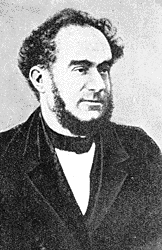Carlo Matteucci
| Carlo Matteucci | |
|---|---|
 |
|
| Born |
21 June 1811 Forlì |
| Died | 25 June 1868 (aged 57) Ardenza |
| Nationality | Italian |
| Fields |
Physics Neurophysiology |
| Institutions | University of Pisa |
| Alma mater | University of Bologna (PhD) (1829) |
| Known for | Bioelectricity |
| Notable awards | Copley Medal (1844) |
Carlo Matteucci (21 June 1811 – 25 June 1868) was an Italian physicist and neurophysiologist who was a pioneer in the study of bioelectricity.
Carlo Matteucci was born at Forlì, in the province of Romagna, to Vincenzo Matteucci, a physician, and Chiara Folfi. He studied mathematics at the University of Bologna from 1825 to 1828, receiving his doctorate in 1829. From 1829 to 1831 he studied at the École Polytechnique in Paris, France. Upon returning to Italy, Matteucci studied at Bologna (1832), Florence, Ravenna (1837) and Pisa. He established himself as the head of the laboratory of the Hospital of Ravenna and became a professor of physics at the local college. In 1840, by recommendation of François Arago (1786–1853), his teacher at the École Polytechnique, to the Grand-Duke of Tuscany, Matteucci accepted a post of professor of physics at the University of Pisa.
Instigated by the work of Luigi Galvani (1737–1798) on bioelectricity, Matteucci began in 1830 a series of experiments which he pursued until his death in 1865. Using a sensitive galvanometer of Leopoldo Nobili, he was able to prove that injured excitable biological tissues generated direct electrical currents, and that they could be summed up by adding elements in series, like in Alessandro Volta’s (1745-1827) electric pile. Thus, Mateucci was able to develop what he called a "rheoscopic frog", by using the cut nerve of a frog’s leg and its attached muscle as a kind of sensitive electricity detector. His work in bioelectricity influenced directly the research developed by Emil du Bois-Reymond (1818–1896), a student of the great German biologist Johannes Peter Müller (1801–1858) in Berlin, who tried the duplicate Matteucci’s experiments and ended up discovering the nerve's action potential. In 1844, for these studies, Matteucci was awarded with the Copley medal by the Royal Society.
...
Wikipedia
